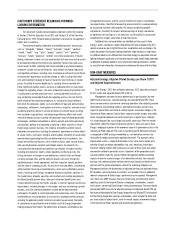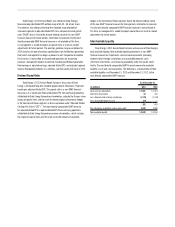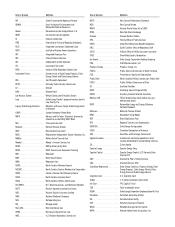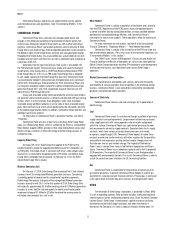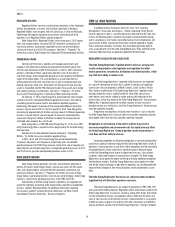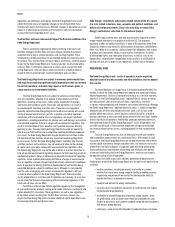Duke Energy 2013 Annual Report Download - page 24
Download and view the complete annual report
Please find page 24 of the 2013 Duke Energy annual report below. You can navigate through the pages in the report by either clicking on the pages listed below, or by using the keyword search tool below to find specific information within the annual report.
PART I
6
general service customers are most impacted by weather. Estimated weather
impacts are based on actual current period weather compared to normal weather
conditions. Normal weather conditions are defined as the long-term average of
actual historical weather conditions.
The estimated impact of weather on earnings is based on the number
of customers, temperature variances from a normal condition and customers’
historic usage levels and patterns. The methodology used to estimate the impact
of weather does not and cannot consider all variables that may impact customer
response to weather conditions such as humidity and relative temperature
changes. The precision of this estimate may also be impacted by applying long-
term weather trends to shorter term periods.
Degree-day data are used to estimate energy required to maintain
comfortable indoor temperatures based on each day’s average temperature.
Heating-degree days measure the variation in weather based on the extent
the average daily temperature falls below a base temperature. Cooling-degree
days measure the variation in weather based on the extent the average daily
temperature rises above the base temperature. Each degree of temperature
below the base temperature counts as one heating-degree day and each degree
of temperature above the base temperature counts as one cooling-degree day.
Competition
Retail
Regulated Utilities’ businesses operate as the sole supplier of electricity
within their service territories, with the exception of Ohio, which has a
competitive electricity supply market. Regulated Utilities owns and operates all of
the facilities necessary to generate, transmit and distribute electricity. Services
are priced by state commission approved rates designed to include the costs
of providing these services and a reasonable return on invested capital. This
regulatory policy is intended to provide safe and reliable electricity at fair prices.
Competition in the regulated electric distribution business is primarily from
on-site generation of industrial customers and distributed generation, such as
rooftop solar, at residential, general service and/or industrial customer sites.
Regulated Utilities is not aware of any proposed legislation in any
jurisdiction that would give its retail customers the right to choose their
electricity provider or otherwise restructure or deregulate the electric industry.
Although there is no pending legislation at this time, if the retail jurisdictions
served by Regulated Utilities become subject to deregulation, the recovery of
stranded costs could become a significant consideration. Stranded costs primarily
include the generation assets of Regulated Utilities whose value in a competitive
marketplace may be less than their current book value, as well as above-market
purchased power commitments from qualified facilities (QFs). QFs are typically small
power production facilities that generate power within a utility company’s service
territory for which the utility companies are legally obligated to purchase the energy
at an avoided cost rate. Thus far, all states that have passed restructuring legislation
have provided for the opportunity to recover a substantial portion of stranded costs.
Regulated Utilities’ largest stranded cost exposure is primarily related to
Duke Energy Florida’s purchased power commitments with QFs, under which it
has future minimum expected capacity payments through 2025 of $3.5 billion.
Duke Energy Florida was obligated to enter into these contracts under provisions
of the Public Utilities Regulatory Policies Act of 1978. Duke Energy Florida
continues to seek ways to address the impact of escalating payments under
these contracts. However, the FPSC allows full recovery of the retail portion of
the cost of power purchased from QFs. See Note 5 to the Consolidated Financial
Statements, “Commitments and Contingencies” for additional information
related these purchased power commitments.
In Ohio, Regulated Utilities conducts competitive auctions for electricity
supply. The cost of energy purchased through these auctions is recovered from
retail customers. Regulated Utilities earns retail margin in Ohio on the transmission
and distribution of electricity only and not on the cost of the underlying energy.
Wholesale
Regulated Utilities competes with other utilities and merchant generators
for bulk power sales, sales to municipalities and cooperatives, and wholesale
transactions. The principal factors in competing for these sales are price,
availability of capacity and power, and reliability of service. Prices are influenced
primarily by market conditions and fuel costs.
Increased competition in the wholesale electric utility industry and
the availability of transmission access could affect Regulated Utilities’ load
forecasts, plans for power supply and wholesale energy sales and related
revenues. Wholesale energy sales will be impacted by the extent to which
additional generation is available to sell to the wholesale market and the ability
of Regulated Utilities to attract new customers and to retain existing customers.
Energy Capacity and Resources
Regulated Utilities owns approximately 50,000 megawatts (MW) of
generation capacity. For additional information on Regulated Utilities’ generation
facilities, see Item 2, “Properties.”
Energy and capacity are also supplied through contracts with other
generators and purchased on the open market. Factors that could cause
Regulated Utilities to purchase power for its customers include generating plant
outages, extreme weather conditions, generation reliability, growth, and price.
Regulated Utilities has interconnections and arrangements with its neighboring
utilities to facilitate planning, emergency assistance, sale and purchase of
capacity and energy, and reliability of power supply.
Regulated Utilities’ generation portfolio is a balanced mix of energy
resources having different operating characteristics and fuel sources designed
to provide energy at the lowest possible cost to meet its obligation to serve retail
customers. All options, including owned generation resources and purchased
power opportunities, are continually evaluated on a real-time basis to select and
dispatch the lowest-cost resources available to meet system load requirements.
Recently Completed Generation Projects
Regulated Utilities completed its generation fleet modernization program in 2013. The additional capacity from this program has allowed Regulated Utilities to
retire or plan to retire older, less efficient capacity. The following table summarizes the generation projects constructed and placed in service during the past three years.
Megawatts Fuel
Commercial
Operation
Cost
(in millions)
Duke Energy Carolinas Cliffside Unit 6 825 Coal 2012 $ 2,100
Duke Energy Carolinas Buck Combined Cycle 620 Natural Gas 2011 675
Duke Energy Carolinas Dan River Combined Cycle 620 Natural Gas 2012 675
Duke Energy Progress H.F. Lee Combined Cycle 920 Natural Gas 2012 725
Duke Energy Progress Smith Combined Cycle 1,084 Natural Gas 2011 575
Duke Energy Progress L.V. Sutton Combined Cycle 625 Natural Gas 2013 575
Duke Energy Indiana Edwardsport IGCC 618 Coal 2013 3,550
Total 5,312 $ 8,875




